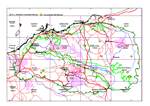Click on images
to enlarge



Photographer: B.R. Maslin

Photographer: B.R. Maslin

Photographer: B.R. Maslin

Photographer: B.R. Maslin
, BRM 8668, lab photo by Fiona McCallum ADJUSTED_sml.jpg)
Seed from one herbarium voucher. Scale in mm. Photographer: F. McCallum.
Botanical name
Acacia retivenea subsp. clandestina Cowan & Maslin, Nuytsia 10: 76 (1995)
Description
Erect, openly branched, often spindly shrubs or small trees 1-4 m tall, with few to several main stems arising from ground level, crowns not dense. Bark grey, smooth except roughened or longitudinally fissured at base of stems on oldest plants. Branchlets densely woolly-felty with soft, usually tolerably long, white, wide-spreading, straight to slightly crinkled hairs. Stipules often persistent, broadly ovate, normally acute, cordate at base, 3-5.5 mm long, 3-5 mm wide, hairy on outer surface, dark brown. Phyllodes ovate or sometimes ±elliptic, normally slightly asymmetric with the upper margin more convex than the lower, mostly 5-8 cm long (few phyllodes on some specimens 3-4 cm long, one Kimberley specimen 12 cm long), 2.5-4.5 (-6) cm wide, thick and coriaceous, normally densely velvety-felty to woolly with short, spreading, soft hairs when young, rarely glabrous, grey-green to sub-glaucous but aging dull green on oldest phyllodes; with (3-) 4 prominent longitudinal nerves and a well-developed, conspicuous reticulum of closely anastomosing nerves in between them; apex rounded-obtuse. Inflorescences mostly simple and initiated within axil of young phyllodes on new shoots, often appearing as 'false' terminal or axillary racemes due to phyllode reduction; peduncles 20-40 mm long, stout, densely softly hairy; heads globular, large (20-25 mm in diameter when fresh, 10-15 mm when dry), golden but often drying orange-brown, densely 71-105-flowered, old flowers persist on receptacles to fruiting stage. Flowers 5-merous; sepals ½-¾-united. Pods oblong to narrowly oblong, ±flat, not constricted between seeds, 4-6 cm long, 15-20 mm wide, hard-crustaceous, straight to shallowly curved, with a dense to relatively sparse, cobwebby indumentum of appressed hairs at maturity. Seeds transverse in the pods, seated within distinct chambers, obloid, 5-7 mm long, not shiny, dark brown; pleurogram bordered by a narrow band of light brown tissue; aril terminal, cream-coloured.
Characteristic features
Branchlets densely woolly-felty hairy. Stipules often persistent, dark brown and quite large (3-5.5 x 3-5 mm). Phyllodes normally slightly asymmetrically ovate, broad and relatively short (mostly 2.5-4.5 cm wide and 5-8 cm long), usually densely velvety-felty to woolly with short, soft hairs, rarely glabrous, coriaceous, with (3-) 4 prominent longitudinal nerves and a well-developed, conspicuous reticulum of closely anastomosing nerves in between them, apex rounded-obtuse. Inflorescences mostly simple but often appearing as 'false' terminal or axillary racemes; heads globular, very large (20-25 mm in diameter when fresh), densely flowered; peduncles (20-40 mm) long and stout, densely softly hairy. Pods oblong to narrowly oblong, ±flat, straight-edged, broad (15-20 mm), hard-crustaceous. Seeds transverse within the pods and seated within discrete chambers.
Distribution and ecology
Subspecies clandestina is confined to northwest and northern Western Australia where it has a scattered distribution that extends from the Barlee Range (Ashburton district) north through the Pilbara to the southern Kimberley region; it extends eastwards to the Paterson Range and Rudall River National Park on the western edge of the Great Sandy Desert. Subspecies clandestina is scattered throughout the Pilbara but is not common; it does not form dense populations but is generally not uncommon in the places where it occurs. It usually grows along rocky creek beds and on rocky hills in skeletal soil in tall shrubland, often associated with Grevillea wickhamii and Acacia tumida. It is also relatively common on the granite tors and nubbins south of Port Hedland in the vicinity of the Abydos-Woodstock Aboriginal Reserve where it grows in skeletal gritty decomposing granitic sand over massive granite. The typical subspecies (subsp. retivenea) extends from the Kimberley region in Western Australia through Northern Territory to Queensland.
Flowering and fruiting period
Pilbara flowering specimens have been collected in May, June, August and October. Pods with mature seeds have been collected from October to December.
Variation
Normally the young and adolescent phyllodes are characteristically velvety-felty to woolly with a dense hair covering and are grey-green to sub-glaucous in colour, however, on oldest phyllodes the indumentum becomes sparser (not felty) and the colour becomes a dull green. One Pilbara collection (from near Wittenoom) is unusual in having glabrous (non-hairy) phyllodes and shorter than normal branchlet hairs which, unlike the normal form of the subspecies, do not persist for very far down the stems.
Taxonomy
Acacia retivenea comprises two, well-marked subspecies whose distributions generally do not overlap, subsp. retivenea (which does not occur in the Pilbara) and subsp. clandestina. Of the several characters distinguishing subsp. retivenea from subsp. clandestina, the most obvious are the nature of its bracteoles, the shape and indumentum of its phyllodes, and the shape and size of its stipules (see Cowan and Maslin 1995 for discussion).
Affinities
Acacia retivenea is most closely related to A. auricoma (which does not occur in the Pilbara) and which is readily recognized by the stellate (star-shaped) hairs that occur on its branchlets and inflorescences.
Notes
Subspecies clandestina resprouts from the base of the stem following a cool burn.
Conservation status
Not considered rare or endangered.
Origin of name
The species name is derived from the Latin retis (a net) and vena (blood vessel) in allusion to the prominent net-like reticulum of anastomosing veins that characterizes the phyllodes. The subspecies name is taken from the Latin clandestinus (hidden or secret) in reference to the long period of time that this entity remained unrecognized as a distinct taxon.
References
Cowan, R.S. and Maslin, B.R. (1995). Acacia miscellany 11. Miscellaneous taxa of northern and eastern Australia of Acacia section Plurinerves (Leguminosae: Mimosoideae). Nuytsia 10(1): 63-84.
